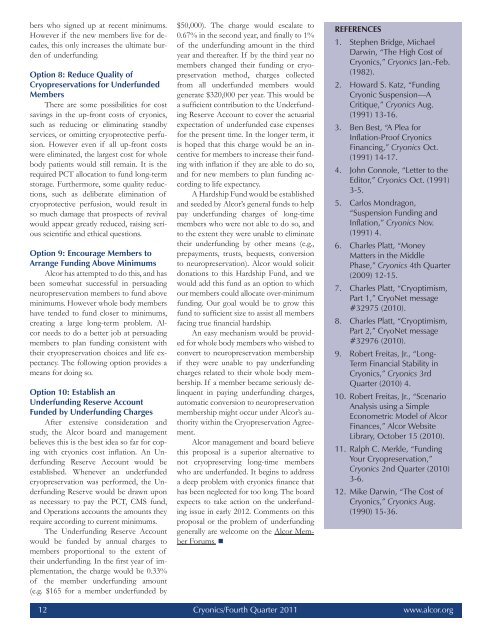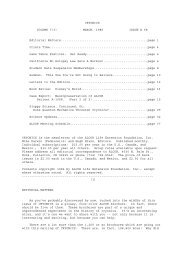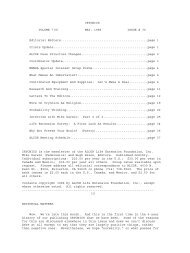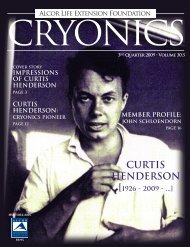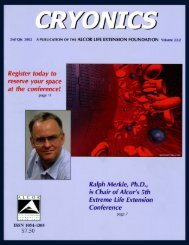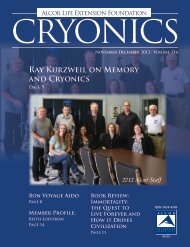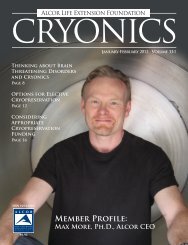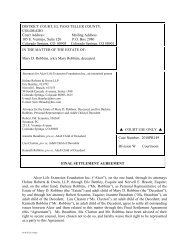Robert Ettinger - Alcor Life Extension Foundation
Robert Ettinger - Alcor Life Extension Foundation
Robert Ettinger - Alcor Life Extension Foundation
Create successful ePaper yourself
Turn your PDF publications into a flip-book with our unique Google optimized e-Paper software.
ers who signed up at recent minimums.<br />
However if the new members live for decades,<br />
this only increases the ultimate burden<br />
of underfunding.<br />
Option 8: Reduce Quality of<br />
Cryopreservations for Underfunded<br />
Members<br />
There are some possibilities for cost<br />
savings in the up-front costs of cryonics,<br />
such as reducing or eliminating standby<br />
services, or omitting cryoprotective perfusion.<br />
However even if all up-front costs<br />
were eliminated, the largest cost for whole<br />
body patients would still remain. It is the<br />
required PCT allocation to fund long-term<br />
storage. Furthermore, some quality reductions,<br />
such as deliberate elimination of<br />
cryoprotective perfusion, would result in<br />
so much damage that prospects of revival<br />
would appear greatly reduced, raising serious<br />
scientific and ethical questions.<br />
Option 9: Encourage Members to<br />
Arrange Funding Above Minimums<br />
<strong>Alcor</strong> has attempted to do this, and has<br />
been somewhat successful in persuading<br />
neuropreservation members to fund above<br />
minimums. However whole body members<br />
have tended to fund closer to minimums,<br />
creating a large long-term problem. <strong>Alcor</strong><br />
needs to do a better job at persuading<br />
members to plan funding consistent with<br />
their cryopreservation choices and life expectancy.<br />
The following option provides a<br />
means for doing so.<br />
Option 10: Establish an<br />
Underfunding Reserve Account<br />
Funded by Underfunding Charges<br />
After extensive consideration and<br />
study, the <strong>Alcor</strong> board and management<br />
believes this is the best idea so far for coping<br />
with cryonics cost inflation. An Underfunding<br />
Reserve Account would be<br />
established. Whenever an underfunded<br />
cryopreservation was performed, the Underfunding<br />
Reserve would be drawn upon<br />
as necessary to pay the PCT, CMS fund,<br />
and Operations accounts the amounts they<br />
require according to current minimums.<br />
The Underfunding Reserve Account<br />
would be funded by annual charges to<br />
members proportional to the extent of<br />
their underfunding. In the first year of implementation,<br />
the charge would be 0.33%<br />
of the member underfunding amount<br />
(e.g. $165 for a member underfunded by<br />
$50,000). The charge would escalate to<br />
0.67% in the second year, and finally to 1%<br />
of the underfunding amount in the third<br />
year and thereafter. If by the third year no<br />
members changed their funding or cryopreservation<br />
method, charges collected<br />
from all underfunded members would<br />
generate $320,000 per year. This would be<br />
a sufficient contribution to the Underfunding<br />
Reserve Account to cover the actuarial<br />
expectation of underfunded case expenses<br />
for the present time. In the longer term, it<br />
is hoped that this charge would be an incentive<br />
for members to increase their funding<br />
with inflation if they are able to do so,<br />
and for new members to plan funding according<br />
to life expectancy.<br />
A Hardship Fund would be established<br />
and seeded by <strong>Alcor</strong>’s general funds to help<br />
pay underfunding charges of long-time<br />
members who were not able to do so, and<br />
to the extent they were unable to eliminate<br />
their underfunding by other means (e.g.,<br />
prepayments, trusts, bequests, conversion<br />
to neuropreservation). <strong>Alcor</strong> would solicit<br />
donations to this Hardship Fund, and we<br />
would add this fund as an option to which<br />
our members could allocate over-minimum<br />
funding. Our goal would be to grow this<br />
fund to sufficient size to assist all members<br />
facing true financial hardship.<br />
An easy mechanism would be provided<br />
for whole body members who wished to<br />
convert to neuropreservation membership<br />
if they were unable to pay underfunding<br />
charges related to their whole body membership.<br />
If a member became seriously delinquent<br />
in paying underfunding charges,<br />
automatic conversion to neuropreservation<br />
membership might occur under <strong>Alcor</strong>’s authority<br />
within the Cryopreservation Agreement.<br />
<strong>Alcor</strong> management and board believe<br />
this proposal is a superior alternative to<br />
not cryopreserving long-time members<br />
who are underfunded. It begins to address<br />
a deep problem with cryonics finance that<br />
has been neglected for too long. The board<br />
expects to take action on the underfunding<br />
issue in early 2012. Comments on this<br />
proposal or the problem of underfunding<br />
generally are welcome on the <strong>Alcor</strong> Member<br />
Forums. �<br />
REFERENCES<br />
1. Stephen Bridge, Michael<br />
Darwin, “The High Cost of<br />
Cryonics,” Cryonics Jan.-Feb.<br />
(1982).<br />
2. Howard S. Katz, “Funding<br />
Cryonic Suspension—A<br />
Critique,” Cryonics Aug.<br />
(1991) 13-16.<br />
3. Ben Best, “A Plea for<br />
Inflation-Proof Cryonics<br />
Financing,” Cryonics Oct.<br />
(1991) 14-17.<br />
4. John Connole, “Letter to the<br />
Editor,” Cryonics Oct. (1991)<br />
3-5.<br />
5. Carlos Mondragon,<br />
“Suspension Funding and<br />
Inflation,” Cryonics Nov.<br />
(1991) 4.<br />
6. Charles Platt, “Money<br />
Matters in the Middle<br />
Phase,” Cryonics 4th Quarter<br />
(2009) 12-15.<br />
7. Charles Platt, “Cryoptimism,<br />
Part 1,” CryoNet message<br />
#32975 (2010).<br />
8. Charles Platt, “Cryoptimism,<br />
Part 2,” CryoNet message<br />
#32976 (2010).<br />
9. <strong>Robert</strong> Freitas, Jr., “Long-<br />
Term Financial Stability in<br />
Cryonics,” Cryonics 3rd<br />
Quarter (2010) 4.<br />
10. <strong>Robert</strong> Freitas, Jr., “Scenario<br />
Analysis using a Simple<br />
Econometric Model of <strong>Alcor</strong><br />
Finances,” <strong>Alcor</strong> Website<br />
Library, October 15 (2010).<br />
11. Ralph C. Merkle, “Funding<br />
Your Cryopreservation,”<br />
Cryonics 2nd Quarter (2010)<br />
3-6.<br />
12. Mike Darwin, “The Cost of<br />
Cryonics,” Cryonics Aug.<br />
(1990) 15-36.<br />
12 Cryonics/Fourth Quarter 2011 www.alcor.org


